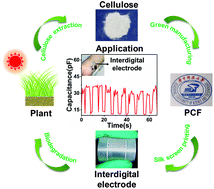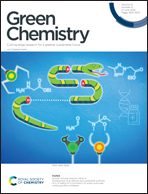Manufacturing pure cellulose films by recycling ionic liquids as plasticizers†
Abstract
Because of the insoluble and infusible properties of cellulose, it is difficult to directly apply cellulose in the manufacture of pure cellulose films (PCFs). Although progress has been achieved in developing eco-friendly fabrication methods including chemical modifications, wet process or thermoplastic process in recent decades, their extreme dependence on a large amount of solvents makes it impossible to attain green manufacturing due to the production of waste liquids and by-products. Herein, by recycling green ionic liquids (ILs) as cellulose plasticizers, a green manufacturing strategy was investigated, in which PCFs, which can be used as flexible cellulose electronic substrates, were successfully manufactured. The results indicated that the properties and structures of PCFs and ILs were essentially unchanged after four cycles; meanwhile, ILs were almost completely recycled and maintained high quality. Compared with the tensile strength of 84.3 MPa and the maximum transmittance of 64.8% of the original PCFs, the mechanical and optical performances of PCFs remained at 83.0 MPa and 64.4% after four cycles, respectively. Moreover, the recovery rates of ILs were higher than 95.0 wt%. Therefore, this study opens a green manufacturing window, which promotes the industrialization of cellulose processing using ILs and the cellulose electronic substrates to substitute the existing artificial polymer electronic substrates.



 Please wait while we load your content...
Please wait while we load your content...